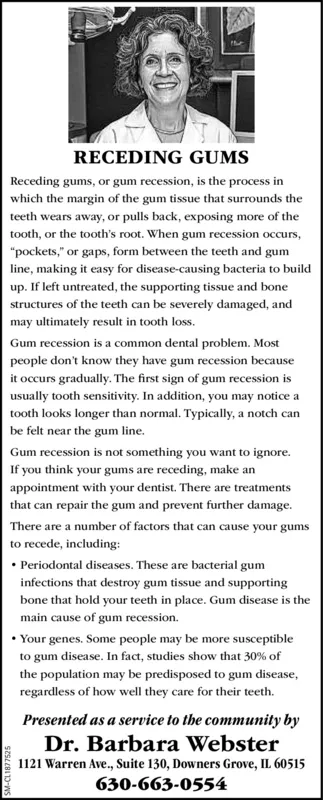Advertisement

-
Published Date
May 26, 2021This ad was originally published on this date and may contain an offer that is no longer valid. To learn more about this business and its most recent offers, click here.
Ad Text
RECEDING GUMS Receding gums, or gum recession, is the process in which the margin of the gum tissue that surrounds the teeth wears away, or pulls back, exposing more of the tooth, or the tooth's root. When gum recession occurs, "pockets," or gaps, form between the teeth and gum line, making it easy for disease-causing bacteria to build up. If left untreated, the supporting tissue and bone structures of the teeth can be severely damaged, and may ultimately result in tooth loss. Gum recession is a common dental problem. Most people don't know they have gum recession because it occurs gradually. The first sign of gum recession is usually tooth sensitivity. In addition, you may notice a tooth looks longer than normal. Typically, a notch can be felt near the gum line. Gum recession is not something you want to ignore. If you think your gums are receding, make an appointment with your dentist. There are treatments that can repair the gum and prevent further damage. There are a number of factors that can cause your gums to recede, including: Periodontal diseases. These are bacterial gum infections that destroy gum tissue and supporting bone that hold your teeth in place. Gum disease is the main cause of gum recession. Your genes. Some people may be more susceptible to gum disease. In fact, studies show that 30% of the population may be predisposed to gum disease, regardless of how well they care for their teeth. Presented as a service to the community by Dr. Barbara Webster 1121 Warren Ave., Suite 130, Downers Grove, IL 60515 630-663-0554 SM-CL1877525 RECEDING GUMS Receding gums, or gum recession, is the process in which the margin of the gum tissue that surrounds the teeth wears away, or pulls back, exposing more of the tooth, or the tooth's root. When gum recession occurs, "pockets," or gaps, form between the teeth and gum line, making it easy for disease-causing bacteria to build up. If left untreated, the supporting tissue and bone structures of the teeth can be severely damaged, and may ultimately result in tooth loss. Gum recession is a common dental problem. Most people don't know they have gum recession because it occurs gradually. The first sign of gum recession is usually tooth sensitivity. In addition, you may notice a tooth looks longer than normal. Typically, a notch can be felt near the gum line. Gum recession is not something you want to ignore. If you think your gums are receding, make an appointment with your dentist. There are treatments that can repair the gum and prevent further damage. There are a number of factors that can cause your gums to recede, including: Periodontal diseases. These are bacterial gum infections that destroy gum tissue and supporting bone that hold your teeth in place. Gum disease is the main cause of gum recession. Your genes. Some people may be more susceptible to gum disease. In fact, studies show that 30% of the population may be predisposed to gum disease, regardless of how well they care for their teeth. Presented as a service to the community by Dr. Barbara Webster 1121 Warren Ave., Suite 130, Downers Grove, IL 60515 630-663-0554 SM-CL1877525
